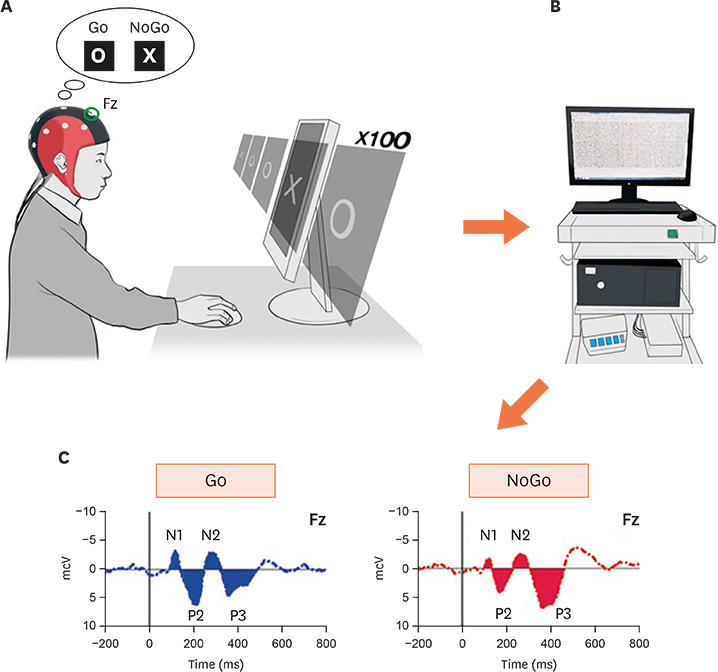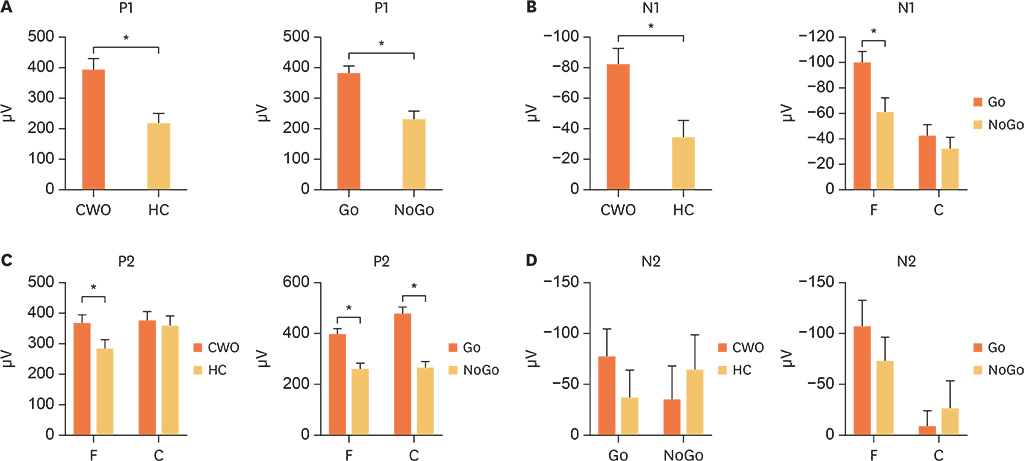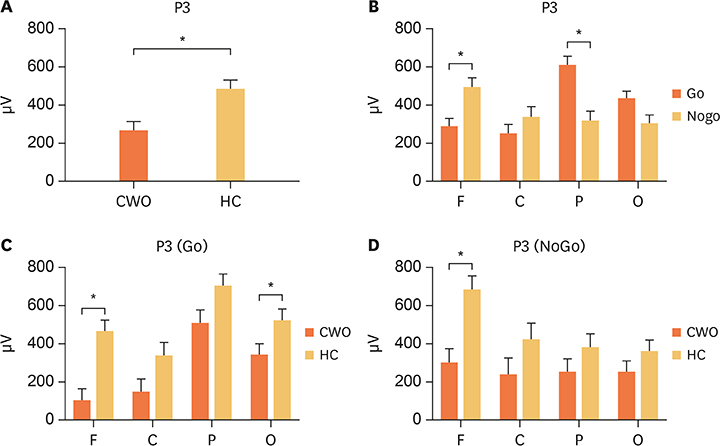Pediatr Gastroenterol Hepatol Nutr.
2019 May;22(3):249-261. 10.5223/pghn.2019.22.3.249.
Visual Hyper-vigilance But Insufficient Mental Representation in Children with Overweight/Obesity: Event-related Potential Study with Visual Go/NoGo Test
- Affiliations
-
- 1Department of Pediatrics, Hanyang University University Guri Hospital, Guri, Korea.
- 2Department of Pediatrics, Hanyang University Medical Center, Hanyang University College of Medicine, Seoul, Korea. kyjoo@hanyang.ac.kr, jinhwamoon@hanyang.ac.kr
- 3Department of Psychiatry, Hanyang University Medical Center, Hanyang University College of Medicine, Seoul, Korea.
- KMID: 2444851
- DOI: http://doi.org/10.5223/pghn.2019.22.3.249
Abstract
- PURPOSE
The neural processing of children with overweight/obesity (CWO), may affect their eating behavior. We investigated the visual information processing of CWO under response control condition, by event-related potential (ERP) study, an electrophysiologic study for cognitive mechanism.
METHODS
Seventeen CWO (mean age: 10.6±1.9), and 17 age-matched non-obese children (NOC), participated in the study. Neurocognitive function tests and visual ERP under Go/NoGo conditions, were implemented. Area amplitudes of major ERP components (P1, N1, P2, N2, and P3) from four scalp locations (frontal, central, parietal, and occipital), were analyzed.
RESULTS
For Go and NoGo conditions, CWO had significantly greater occipital P1, fronto-central N1, and P2 amplitudes compared with NOC. P2 amplitude was significantly greater in CWO, than in NOC, at the frontal location. N2 amplitude was not significantly different, between CWO and NOC. For CWO and NOC, Go P3 amplitude was highest at the parietal location, and NoGo P3 amplitude was highest at the frontal location. In Go and NoGo conditions, P3 amplitude of CWO was significantly less than in NOC.
CONCLUSION
The greater P1, N1, and P2 suggested hyper-vigilance to visual stimuli of CWO, but the smaller P3 suggested insufficient mental representation of them. Such altered visual processing, may affect the eating behavior of CWO.
Keyword
MeSH Terms
Figure
Reference
-
1. Pulgarón ER. Childhood obesity: a review of increased risk for physical and psychological comorbidities. Clin Ther. 2013; 35:A18–A32.
Article2. Khan NA, Raine LB, Donovan SM, Hillman CH. IV. The cognitive implications of obesity and nutrition in childhood. Monogr Soc Res Child Dev. 2014; 79:51–71.
Article3. Agustí A, García-Pardo MP, López-Almela I, Campillo I, Maes M, Romaní-Pérez M, et al. Interplay between the gut-brain axis, obesity and cognitive function. Front Neurosci. 2018; 12:155.
Article4. Hofmann J, Ardelt-Gattinger E, Paulmichl K, Weghuber D, Blechert J. Dietary restraint and impulsivity modulate neural responses to food in adolescents with obesity and healthy adolescents. Obesity (Silver Spring). 2015; 23:2183–2189.
Article5. Park EH, Oh MS, Kim S, Lee J, Kang KS. The analysis of factors causing the high prevalence of child obesity in Jeju island. Pediatr Gastroenterol Hepatol Nutr. 2018; 21:127–133.
Article6. Pauli-Pott U, Albayrak O, Hebebrand J, Pott W. Association between inhibitory control capacity and body weight in overweight and obese children and adolescents: dependence on age and inhibitory control component. Child Neuropsychol. 2010; 16:592–603.
Article7. Wirt T, Schreiber A, Kesztyüs D, Steinacker JM. Early life cognitive abilities and body weight: cross-sectional study of the association of inhibitory control, cognitive flexibility, and sustained attention with BMI percentiles in primary school children. J Obes. 2015; 2015:534651.
Article8. Erhart M, Herpertz-Dahlmann B, Wille N, Sawitzky-Rose B, Hölling H, Ravens-Sieberer U. Examining the relationship between attention-deficit/hyperactivity disorder and overweight in children and adolescents. Eur Child Adolesc Psychiatry. 2012; 21:39–49.
Article9. Deux N, Schlarb AA, Martin F, Holtmann M, Hebebrand J, Legenbauer T. Overweight in adolescent, psychiatric inpatients: a problem of general or food-specific impulsivity? Appetite. 2017; 112:157–166.
Article10. Carbine KA, Duraccio KM, Kirwan CB, Muncy NM, LeCheminant JD, Larson MJ. A direct comparison between ERP and fMRI measurements of food-related inhibitory control: implications for BMI status and dietary intake. Neuroimage. 2018; 166:335–348.
Article11. Joutsa J, Karlsson HK, Majuri J, Nuutila P, Helin S, Kaasinen V, et al. Binge eating disorder and morbid obesity are associated with lowered mu-opioid receptor availability in the brain. Psychiatry Res Neuroimaging. 2018; 276:41–45.
Article12. Val-Laillet D, Aarts E, Weber B, Ferrari M, Quaresima V, Stoeckel LE, et al. Neuroimaging and neuromodulation approaches to study eating behavior and prevent and treat eating disorders and obesity. Neuroimage Clin. 2015; 8:1–31.
Article13. Johnstone SJ, Barry RJ, Clarke AR. Ten years on: a follow-up review of ERP research in attention-deficit/hyperactivity disorder. Clin Neurophysiol. 2013; 124:644–657.
Article14. Chen L, Zhou Y, Liu L, Zhang X, Zhang H, Liu S. Cortical event-related potentials in Alzheimer's disease and frontotemporal lobar degeneration. J Neurol Sci. 2015; 359:88–93.
Article15. Duncan CC, Barry RJ, Connolly JF, Fischer C, Michie PT, Näätänen R, et al. Event-related potentials in clinical research: guidelines for eliciting, recording, and quantifying mismatch negativity, P300, and N400. Clin Neurophysiol. 2009; 120:1883–1908.
Article16. Onitsuka T, Oribe N, Nakamura I, Kanba S. Review of neurophysiological findings in patients with schizophrenia. Psychiatry Clin Neurosci. 2013; 67:461–470.
Article17. Klimesch W. Alpha-band oscillations, attention, and controlled access to stored information. Trends Cogn Sci. 2012; 16:606–617.
Article18. Klimesch W, Sauseng P, Hanslmayr S. EEG alpha oscillations: the inhibition-timing hypothesis. Brain Res Brain Res Rev. 2007; 53:63–88.
Article19. Luck SJ. An introduction to the event-related potential technique. 2nd ed. Cambridge (MA): MIT Press;2014.20. Polich J. Updating P300: an integrative theory of P3a and P3b. Clin Neurophysiol. 2007; 118:2128–2148.
Article21. Gao H, Qi M, Zhang Q. Response inhibition is more effortful than response activation: behavioral and electrophysiological evidence. Neuroreport. 2017; 28:404–407.22. Tascilar ME, Turkkahraman D, Oz O, Yucel M, Taskesen M, Eker I, et al. P300 auditory event-related potentials in children with obesity: is childhood obesity related to impairment in cognitive functions? Pediatr Diabetes. 2011; 12:589–595.
Article23. Reyes S, Peirano P, Peigneux P, Lozoff B, Algarin C. Inhibitory control in otherwise healthy overweight 10-year-old children. Int J Obes. 2015; 39:1230–1235.
Article24. de Onis M, Onyango AW, Borghi E, Siyam A, Nishida C, Siekmann J. Development of a WHO growth reference for school-aged children and adolescents. Bull World Health Organ. 2007; 85:660–667.
Article25. Tarantino V, Vindigni V, Bassetto F, Pavan C, Vallesi A. Behavioral and electrophysiological correlates of cognitive control in ex-obese adults. Biol Psychol. 2017; 127:198–208.
Article26. Kamijo K, Pontifex MB, Khan NA, Raine LB, Scudder MR, Drollette ES, et al. The association of childhood obesity to neuroelectric indices of inhibition. Psychophysiology. 2012; 49:1361–1371.
Article27. Hume DJ, Howells FM, Rauch HG, Kroff J, Lambert EV. Electrophysiological indices of visual food cue-reactivity. Differences in obese, overweight and normal weight women. Appetite. 2015; 85:126–137.
Article28. Key AP, Dykens EM. ‘Hungry Eyes’: visual processing of food images in adults with Prader-Willi syndrome. J Intellect Disabil Res. 2008; 52:536–546.
Article29. Hoyniak C. Changes in the NoGo N2 event-related potential component across childhood: a systematic review and meta-analysis. Dev Neuropsychol. 2017; 42:1–24.
Article30. Tsai CL, Chen FC, Pan CY, Tseng YT. The neurocognitive performance of visuospatial attention in children with obesity. Front Psychol. 2016; 7:1033.
Article31. Nijs IM, Muris P, Euser AS, Franken IH. Differences in attention to food and food intake between overweight/obese and normal-weight females under conditions of hunger and satiety. Appetite. 2010; 54:243–254.
Article
- Full Text Links
- Actions
-
Cited
- CITED
-
- Close
- Share
- Similar articles
-
- Event-Related Potentials During the Visual Go/NoGo Task in Drug-Naive Boys with Attention-Deficit/Hyperactivity Disorder
- Impulsivity in Major Depressive Disorder Patients with Suicidal Ideation: Event-related Potentials in a GoNogo Task
- A Study of Visual Event-Related Potential P300 in Schizophrenia
- Comparison of the Response Inhibitory Event Related Potential between Suicide Attempt and Ideation
- Age-Related Changes in Auditory Nogo-N200 Latency in Medication-Naïve Children and Adolescents with Attention-Deficit/Hyperactivity Disorder





